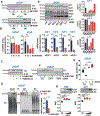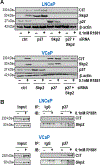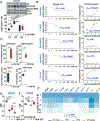Prostate Cancer Progression Relies on the Mitotic Kinase Citron Kinase
- PMID: 37801613
- PMCID: PMC10841833
- DOI: 10.1158/0008-5472.CAN-23-0883
Prostate Cancer Progression Relies on the Mitotic Kinase Citron Kinase
Abstract
Prostate cancer remains the second leading cause of cancer death in men in Western cultures. A deeper understanding of the mechanisms by which prostate cancer cells divide to support tumor growth could help devise strategies to overcome treatment resistance and improve survival. Here, we identified that the mitotic AGC family protein kinase citron kinase (CIT) is a pivotal regulator of prostate cancer growth that mediates prostate cancer cell interphase progression. Increased CIT expression correlated with prostate cancer growth induction and aggressive prostate cancer progression, and CIT was overexpressed in prostate cancer compared with benign prostate tissue. CIT overexpression was controlled by an E2F2-Skp2-p27 signaling axis and conferred resistance to androgen-targeted treatment strategies. The effects of CIT relied entirely on its kinase activity. Conversely, CIT silencing inhibited the growth of cell lines and xenografts representing different stages of prostate cancer progression and treatment resistance but did not affect benign epithelial prostate cells or nonprostatic normal cells, indicating a potential therapeutic window for CIT inhibition. CIT kinase activity was identified as druggable and was potently inhibited by the multikinase inhibitor OTS-167, which decreased the proliferation of treatment-resistant prostate cancer cells and patient-derived organoids. Isolation of the in vivo CIT substrates identified proteins involved in diverse cellular functions ranging from proliferation to alternative splicing events that are enriched in treatment-resistant prostate cancer. These findings provide insights into the regulation of aggressive prostate cancer cell behavior by CIT and identify CIT as a functionally diverse and druggable driver of prostate cancer progression.
Significance: The poorly characterized protein kinase citron kinase is a therapeutic target in prostate cancer that drives tumor growth by regulating diverse substrates, which control several hallmarks of aggressive prostate cancer progression. See related commentary by Mishra et al., p. 4008.
©2023 American Association for Cancer Research.
Conflict of interest statement
Figures








Comment in
-
Citron Kinase Is a Druggable Target in Treatment-Resistant Prostate Cancer.Cancer Res. 2023 Dec 15;83(24):4008-4009. doi: 10.1158/0008-5472.CAN-23-2858. Cancer Res. 2023. PMID: 38098450
References
Publication types
MeSH terms
Substances
Grants and funding
LinkOut - more resources
Full Text Sources
Medical
Molecular Biology Databases
Miscellaneous

